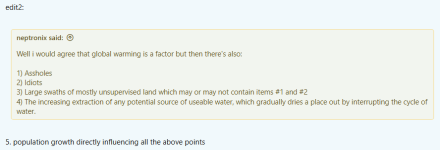re: the chatGPT comment
"I am using it as example to showcase what someone needs to use for information when they are from another part of the planet See it as a sign post for people to post more sources with their claims, it will help people from other regions and prevent them from having to ask Bing / ChatGpt because as you say they do hallucinate a lot and are very good at confirming underlying insinuations in questions even if completely off the mark."
See it as a sign post for people to post more sources with their claims, it will help people from other regions and prevent them from having to ask Bing / ChatGpt because as you say they do hallucinate a lot and are very good at confirming underlying insinuations in questions even if completely off the mark."
Hey, that's basically admitting you don't know much about this situation and you're googling/GPT-ing stuff just to counter argue.
Nobody's compelling you to make arguments about things you don't have a good understanding of. It would be better if zero people on the internet did that.
If this is the angle you're taking, i'm out, i don't agree to the terms of argument!

Confused why you're quoting something i didn't say. Editing error?
"I am using it as example to showcase what someone needs to use for information when they are from another part of the planet
Hey, that's basically admitting you don't know much about this situation and you're googling/GPT-ing stuff just to counter argue.
Nobody's compelling you to make arguments about things you don't have a good understanding of. It would be better if zero people on the internet did that.
If this is the angle you're taking, i'm out, i don't agree to the terms of argument!

Confused why you're quoting something i didn't say. Editing error?
Last edited:









